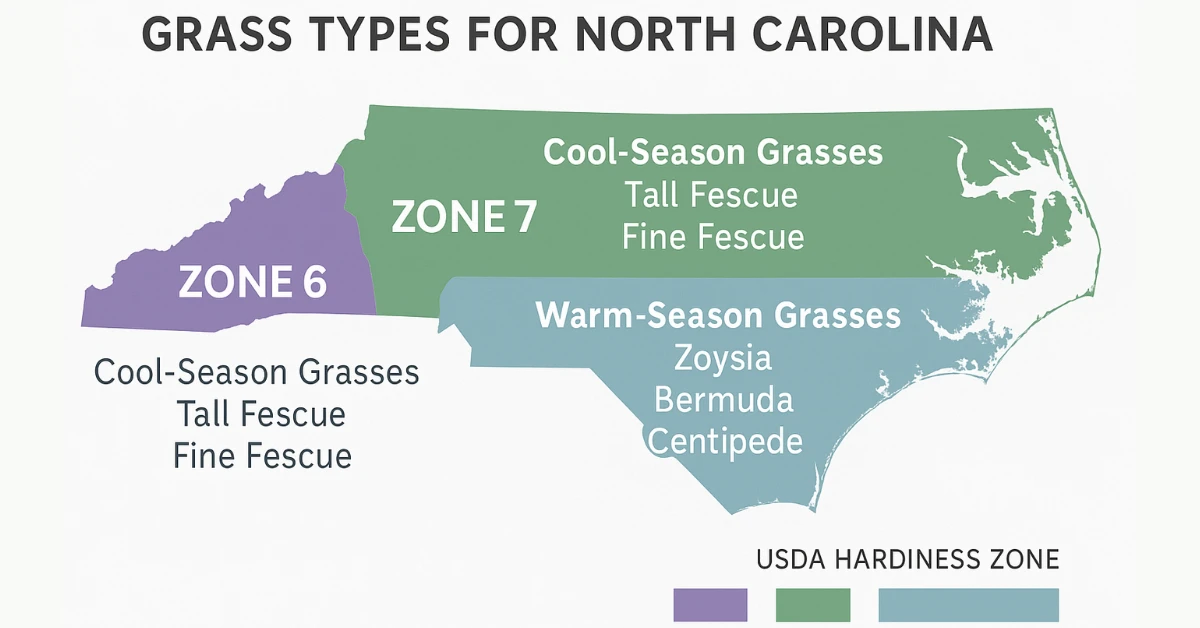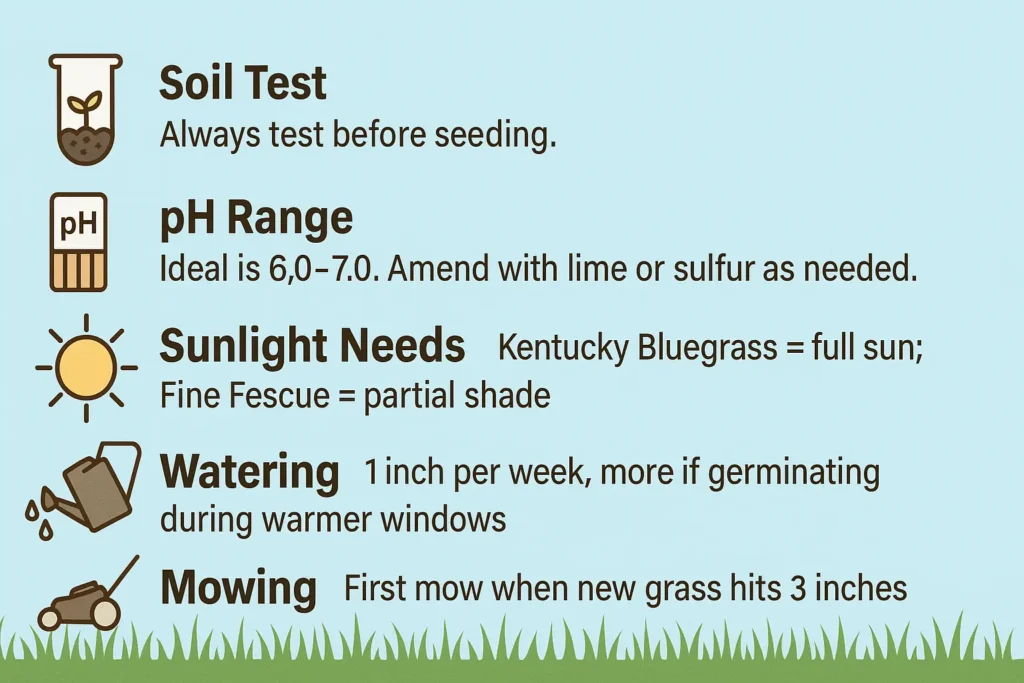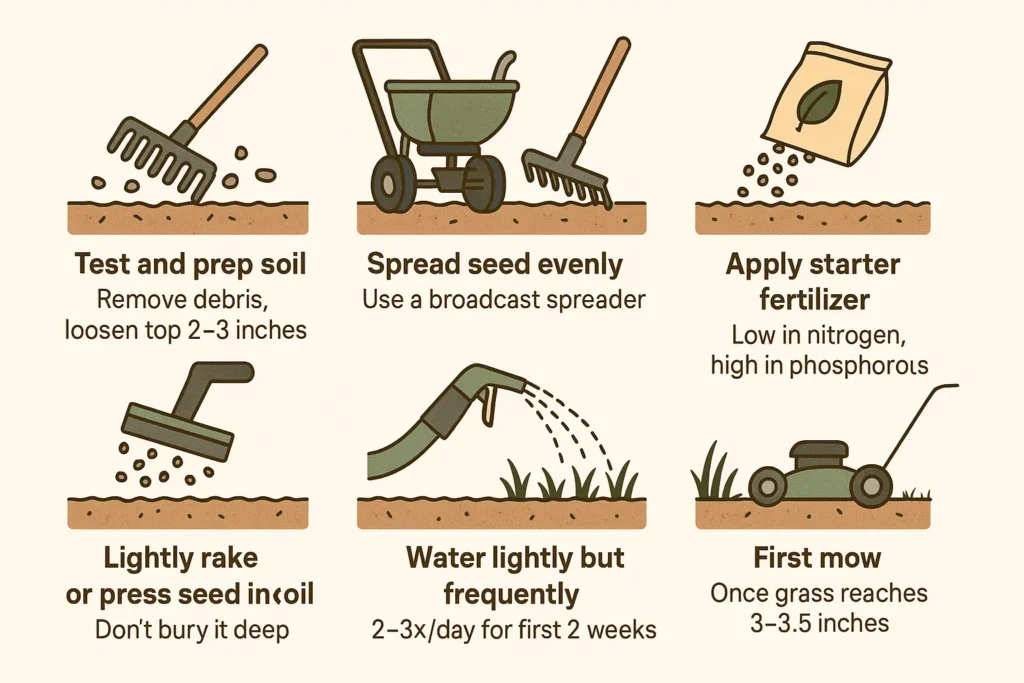When to Plant Grass Seed in North Carolina: Seasonal Guide for Every Lawn

When it comes to lawn care in the South, timing is everything. If you’re wondering when to plant grass seed in North Carolina, this comprehensive guide covers the ideal planting windows, best grass types for your region, USDA zones, and everything you need to know to grow a thriving lawn in NC’s diverse climate.
Whether you’re in the mountains, Piedmont, or coastal plains, planting success starts with good timing and the right seed.
When to Plant Grass Seed in North Carolina?
The best time to plant grass seed in North Carolina depends on whether you’re planting cool-season or warm-season grass. Since the state spans USDA zones 6a to 8b, both types can work—but the timing is different.
For cool-season grasses (like Fescues and Ryegrass), the optimal window is mid-September to mid-November. These grasses thrive in the cooler months and get a head start before summer heat arrives.
For warm-season grasses (like Bermuda and Zoysia), you’ll want to seed in late spring through early summer, once soil temps are consistently above 65°F—usually around mid-April to early June.
If you’re trying to decide when to plant grass seed in North Carolina, the season and seed type matter most.
North Carolina’s USDA Hardiness Zones
North Carolina’s climate varies more than many expect. The state covers USDA zones 6a to 8b, which means your planting window and grass type will vary depending on where you live.
Zone: 6a–6b
Region: Western NC (Mountains)
Grass: Tall Fescue, Kentucky Bluegrass
Zone: 7a–7b
Region: Piedmont Region
Grass: Tall Fescue, Perennial Rye, Zoysia
Zone: 8a–8b
Region: Coastal Plains & Southeast
Grass: Bermuda, Centipede, Zoysia
The elevation and temperature range in western North Carolina favor cool-season grasses, while the hotter and more humid coastal region supports warm-season varieties.
Understanding your hardiness zone is essential when planning when to plant grass seed in North Carolina.
🔍 Not sure what zone you’re in? You can look up your zone here.
Best Grass Seed Types for North Carolina
Before you plant anything, make sure you choose the right seed for your region. Here are the most reliable grass types for North Carolina and where they perform best:
Tall Fescue
This is the most commonly used grass in North Carolina, especially in the Piedmont and western areas. It’s durable, cool-season, and handles foot traffic well. It does need regular watering in summer.
Kentucky Bluegrass
Bluegrass prefers cooler climates and is typically used in mixes with Fescue in the western and northern parts of the state. It has a dense, carpet-like look and good cold tolerance.
Perennial Ryegrass
Great for quick germination and overseeding, Ryegrass is a fast starter but may struggle with NC’s summer heat if used alone. Often blended with Fescue.
Bermuda
A favorite in southern and coastal NC, Bermuda thrives in hot, sunny locations and spreads quickly. It goes dormant in winter but rebounds in spring.
Zoysia
Zoysia is a warm-season grass that grows slowly but forms a dense, weed-resistant lawn. Best for transition zones like central NC.
Centipede
Low-maintenance and slow-growing, Centipede is ideal for coastal areas. It handles acidic soil and low fertility, making it great for homeowners who want less fuss.
The seed you choose determines when to plant grass seed in North Carolina, so match your lawn goals and location to the right grass type.
Grass Seeding Schedule by Season
Spring
- Warm-season grasses only
- Plant from mid-April to early June
- Make sure soil temps are 65°F+
- Risk: early heatwaves or late cold snaps
Fall (Best for Cool-Season Grass)
- Seed from mid-September to mid-November
- Great for Fescue, Rye, and Bluegrass
- Soil still warm enough for germination
- Rainfall is typically favorable
Summer
- Only plant warm-season grasses if you can irrigate
- Avoid cool-season planting — the heat is too intense
Winter
- Dormant seeding is possible in late November
- Not recommended unless you’re experienced with cool-season turf
If you’re unsure when to plant grass seed in North Carolina, aim for fall for cool-season grass and late spring for warm-season grass, based on your zone.
Soil, Water, and Light Requirements
No matter the timing, success starts in the soil.
- Soil Test: Check pH (ideal 6.0–7.0) and nutrient levels before planting.
- Aeration: Fall is a good time to aerate compacted Piedmont clay soils.
- Sunlight: Bermuda and Zoysia need full sun. Fescue tolerates partial shade.
- Watering: Keep seeded areas moist during germination—light watering 2–3x/day.
- Mowing: Mow new grass when it reaches 3–4 inches high.
Even if you know when to plant grass seed in North Carolina, skipping soil prep or irrigation during germination can waste your effort.
Mistakes to Avoid When Seeding in North Carolina
These common missteps can turn a promising lawn into a patchy mess:
- Seeding warm-season grass too early — soil won’t be warm enough
- Skipping seed-to-soil contact — results in poor germination
- Ignoring pH and soil structure — acidic or compacted soil hinders root growth
- Overwatering or underwatering during germination
- Planting cool-season grass in summer — heat stress kills young shoots
Avoiding these pitfalls matters just as much as knowing when to plant grass seed in North Carolina.
How to Plant Grass Seed in North Carolina?
- Test your soil and amend if needed
- Prepare the site: dethatch and loosen topsoil
- Spread your seed evenly with a broadcast spreader
- Lightly rake and roll to ensure seed-to-soil contact
- Apply a starter fertilizer for root development
- Water lightly but consistently for 2–3 weeks
- Mow when grass reaches 3–4 inches
Following this process ensures your planting window doesn’t go to waste. And yes, when to plant grass seed in North Carolina still matters, but this method makes it count.
Regional Differences Within North Carolina
North Carolina’s geography plays a big role in what—and when—you should plant.
Mountains
Fall seeding is best; cool-season only
Piedmont
Best of both: Fall (cool) and Spring (warm)
Coastal Plains
Warm-season grass, planted late spring
Western NC residents should focus on Tall Fescue and Ryegrass in early fall. Meanwhile, homeowners near Wilmington or the Outer Banks can wait until May to plant Bermuda or Centipede.
If you’re wondering when to plant grass seed in North Carolina, your region makes a big difference.
Tools and Resources to Help You Plant Smarter
To make your lawn care even easier, check out these helpful tools and planners on our site:
- ✅ Grass Seed Calculator
- ✅ Lawn Fertilizer Calculator – Apply the right amount of nutrients based on lawn size and grass type
- ✅ Lawn Mowing Cost Calculator – Estimate mowing expenses by lawn size, frequency, and contractor pricing
- ✅ Lawn Care Cost Calculator – Budget for overseeding, watering, fertilizing, and more
Knowing when to plant grass seed in North Carolina is just one piece. These tools help you plan and adjust based on your local conditions.
Referenced Expert Guide
For additional insights backed by research, we recommend reading this expert summary on grass seed sowing by Conservation Evidence. It explores what works (and what doesn’t) based on global field trials and supports many of the practices shared here.
Whether you’re testing dormant seeding or choosing between Fescue types, it’s a solid external reference that complements our region-specific guide.
Final Thoughts: When to Plant Grass Seed in North Carolina
To sum it up, when to plant grass seed in North Carolina depends on your location, climate zone, and chosen grass type:
- Cool-season grasses: Best planted mid-September to mid-November
- Warm-season grasses: Best planted mid-April to early June
- Match your grass type to your USDA hardiness zone
- Prep your soil, irrigate consistently, and avoid common seeding mistakes
Still unsure? Use our tools or visit our in-depth resource:
👉 Best Time to Plant Grass Seed (Guide)
A healthy, green lawn in North Carolina isn’t about luck—it’s about planting the right grass at the right time, with the right preparation.


